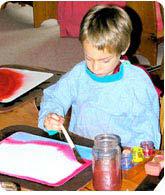Just in time for Earth Day! The Green Curriculum in Waldorf Schools April 21 2023
A Twelve Part Series
From Roots to Bloom
A few years ago on AWSNA’s “Green Pages” Sarah Hearn, Waldorf graduate from the New York City Rudolf Steiner School, with help from a class teacher or two, wrote a series of short articles on the many ways in which the curriculum in our schools connects a child to the Earth, awakens a devoted love of Nature and grows environmentalists who carry a passion for caring for the Earth and all its gifts. Sarah has agreed to have these little articles republished as a guest blogger here. She called her series “From Roots to Bloom,” to emphasize the growth in a human being as reflected in the plant kingdom. We are delighted about Sarah’s giving us permission as this overview of the “green curriculum” bears repeating many times. Embedded as it is in all that’s done in Waldorf schools, it’s wonderful to see it teased out for a minute to reveal some of its better parts!
Sarah started her “From Roots to Bloom” in grade one. She did this, in part, because the Kindergarten doesn’t have a “curriculum” per se. Life is the “curriculum,” and the dedicated Kindergarten teachers organize life in the Kindergarten to provide little ones with a rhythmical approach to the ordinary glory of everyday in such a way that children can participate and learn by doing. They bake bread, make soup, cut vegetables and prepare a delicious meal each day for all to share. They set the table, hear stories, care for plants and animals in the Kindergarten and its yard. They take long walks that devote great attention on things in nature as they grow and change with each season. Most importantly, they play and play and play inside and outside for long stretches of time. Through all this they learn to love their world, they learn to count, to skip, to jump rope, to run, to swing, to sing, to listen, to color, to paint and to fill each day with splendid activities that underscore their automatic disposition to enjoy and love the Earth, the world, their lives. This engenders an inner attitude of gratitude and love — essential tools for a happy life. Unpressed by tests and academic demands, they come to yearn to learn more instead of being driven to do what others have decided they should master. Kindergarten teachers devote their full attention on sculpting a beautiful, calm, organized environment that allows for children to learn to love people and things beyond their families, and to care for the things in the Kindergarten space with dedication and joy.
So, here comes part 1 of a 12 part series from a graduate’s own experience....
From Roots to Bloom: Green in Grade One
Waldorf Schools strive to co-exist in a profoundly felt, right relationship with the Earth throughout the grades, building inner habits that prepare children to be environmentalists on the deepest levels. The practices and experiences which engender these inner habits are embedded in all aspects of the Waldorf School curriculum from grade one to grade twelve! We will explore and highlight some of the elements and ways in which environmental sustainability lives and breathes through the Waldorf curriculum. We begin with a brief exploration of Grade One!
 Daily experiences of colorful nature stories and fairy tales paint a rich tapestry for the first grade child, encouraging a sense of wonder and close relationship to nature, her elements, and inhabitants. These stories, along with songs, verses, and poems, come to life in the children's imaginations as the class teacher shares them orally, simultaneously offering a deep and engaged relationship to language, rhyme and rhythm, the building blocks for further language learning, reading and writing. First graders make daily connections to the environment around them with their other senses as well. The children find their way to an intimate link to the natural world through plenty of time spent in the outdoors, in the woods, fields, parks, and window-box gardens of Waldorf Schools throughout North America. Day by day, these opportunities bring them to an appreciation for the seasons, and for the mineral, plant and animal kingdoms, guided by their own experiences. Inside the classroom, they live through myriad artistic experiences to a love and knowledge of the earth's substances, through water color painting, modeling forms with beeswax, and beginning to knit with wool. These activities and many more further encourage the children's awe and respect for Mother Earth.
Daily experiences of colorful nature stories and fairy tales paint a rich tapestry for the first grade child, encouraging a sense of wonder and close relationship to nature, her elements, and inhabitants. These stories, along with songs, verses, and poems, come to life in the children's imaginations as the class teacher shares them orally, simultaneously offering a deep and engaged relationship to language, rhyme and rhythm, the building blocks for further language learning, reading and writing. First graders make daily connections to the environment around them with their other senses as well. The children find their way to an intimate link to the natural world through plenty of time spent in the outdoors, in the woods, fields, parks, and window-box gardens of Waldorf Schools throughout North America. Day by day, these opportunities bring them to an appreciation for the seasons, and for the mineral, plant and animal kingdoms, guided by their own experiences. Inside the classroom, they live through myriad artistic experiences to a love and knowledge of the earth's substances, through water color painting, modeling forms with beeswax, and beginning to knit with wool. These activities and many more further encourage the children's awe and respect for Mother Earth.
